Why Your Solution Will be Adored or Ignored: Understanding the Attention-Value Matrix
I’ve always loved studying the various approaches, formulae, messages, and tactics vendors use to gain the interest and attention of their target buyers. As a buyer, I’ve seen compelling examples of them. I’ve also seen some of the most brutal. But through it all, I’ve noticed an interesting mathematical relationship between two critical factors; the perceived value of your solution and the attention you need from your target buyer in order to convert, or at the very least engage, them. As a modern seller or marketer, understanding this relationship is critical to ensuring you focus on the tactics and activities that get you the best return. Let me explain.
Some products and services are unique, innovative, and amazing. Their value propositions are compelling and clear: like the iPhone or a Tesla car. Others are mainstream and exist in a marketplace of undifferentiated similar solutions: like running shoes and flatscreen TVs. At the same time, some sales and marketing organizations do a fantastic job of capturing a buyer’s imagination and mindshare. Others can barely raise an eyebrow.
My first take at describing that relationship was the simple inverse graph illustrated below.
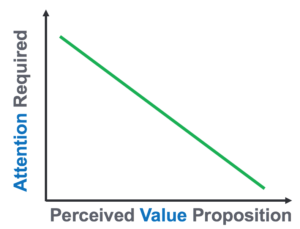
The principle is that as the perceived value of a product increases, the degree of attention or mindshare you need from a customer in order to take notice decreases. For example, Apple rarely has to do any heavy marketing in order to whip up a frenzy around the release of their latest products. They simply issue a press release letting everyone know when they plan to make their next official announcement, and thousands of news outlets around the world immediately begin to rally around leaked specifications, clues, and scraps of disparate data points, to speculate on the details of the forthcoming devices. Apple’s products are examples of an elite, game-changing variety. As a result, they require little attention or discretionary mindshare on the part of buyers in order to take notice.
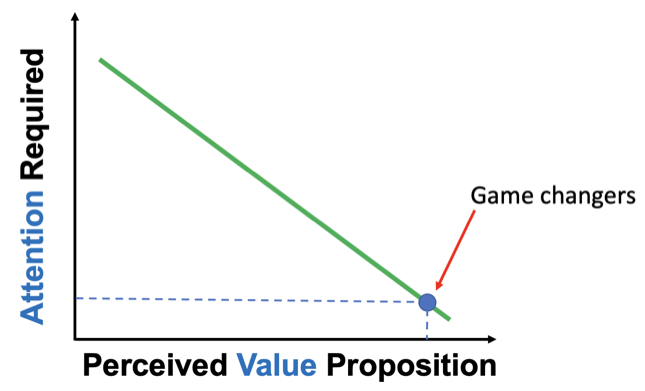
On the flip side, when McDonald’s announces a new kind of hamburger, a consumer may have to see it advertized dozens (if not hundreds) of times on billboards, commercials, and transit ads before they start to notice. High perceived value results in a low attention requirement. Low perceived value, on the other hand, requires a high degree of attention.
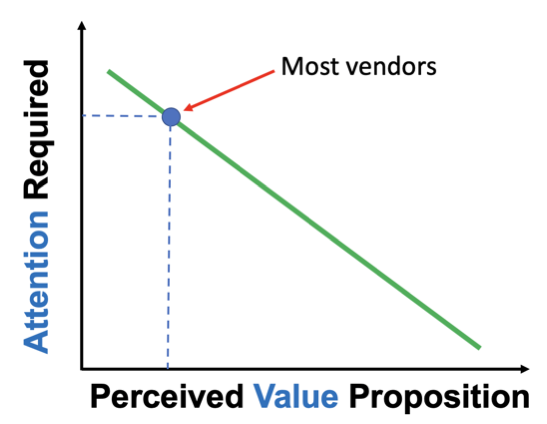
Unfortunately, without the notoriety of an iPhone or Tesla, most vendors require a significant amount of customer attention in order to have their value proposition land. Consider the menu of value propositions typically associated with B2B technologies below. In the modern marketplace, most solutions help:
- Reduce – cost, risk, exposure, manual errors
- Improve – efficiency, retention, brand awareness
- Expand – reach, insight, automation capabilities
- Grow – revenue, customer base, brand loyalty, etc.
Was one or more of your company’s key value propositions represented in this list? If so, chances are that your value has a high risk of getting lost in a sea of similar-sounding solutions. Of course, since the goal of most companies is to have the value of their solutions be rapidly internalized and understood, it’s important to understand where yours falls on this matrix. From there you will have a better sense for how to moderate your approach.
Shifting the simple inverse graph to a quadrant format (i.e., the Attention/Value matrix) provides additional clarity:
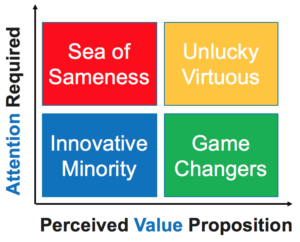
Game Changers

When it comes to Game Changers, buyers see the value of not only their products but the innovation they bring to the market as high. While their advertizing spend may be large, in a sea of solution providers, they are well-differentiated and do not need to invest much effort in order to attract their buyer’s attention. Apple doesn’t just sell phones, gadgets, and accessories. They sell brilliant designs, user-centricity, and engineering triumphs. Tesla doesn’t just sell cars. They sell a vision of the future of the planet. As proof, with zero advertizing dedicated to their entry-level electric car, the Model 3, Telsa secured approximately half a million orders within the first quarter of launch.
To provide a different type of example, suppose that, after years of hard work and experimentation, a small, little-known life-sciences research group at the University of Toronto discovered a definitive cure for cancer. With zero advertizing dollars or marketing plan, it’s likely that this kind of news would rip through news outlets around the world at a lightning-fast pace. Billions would instantly stop what they were doing and pay attention. That’s the power of Game Changers.
Most Game Changers are mission-driven organizations, and their followers are disciples. If your solution has the potential to be part of this elite group, a go-to-market plan that showcases your belief system (i.e., how you intend to make a dent in the universe) should dominate your overall strategy.
Sea of Sameness
Unfortunately, most product and service providers fall into this category, as do fast-food restaurants, banks, and pencil manufacturers. On the surface, the perceived value and differentiation of these organizations is low. That means they require more effort and ingenuity to secure the attention of their target buyers.
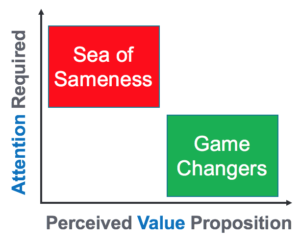
For example, in the Marketing Technology space alone, the number of vendors has increased from 150 to over 7000 from 2011 to 2019. Many of these solutions (or new features for existing products) are not revolutionary, but instead represent variations or improvements on existing solutions. The same principle can be applied to real estate agents, TV’s, personal injury lawyers, lawnmowers, and even banks. It’s not that these products, services, or professionals don’t have the potential to be game-changing or highly differentiated, but because they all sound the same on the surface, it’s rare that buyers are inclined to dive deeper.
Buyer inertia, is a defence mechanism designed to protect our focus. It blissfully carries prospective buyers forward, employing the same products, policies, and practices they’ve always used, oblivious to your solution. If you have ever been to a vendor expo at any conference you know what I mean. Dozens of vendors with signage that all says the same thing: “Increase win rates by X%,” “Reduce administrative costs by Y%,” “Improve customer satisfaction by Z%.” Without innovative tactics and messaging, their sales and marketing teams won’t break through enough defenses to capture widespread attention.
This is where vendors fall into limbo. If you feel your organization exists in the Sea of Sameness, your goal should be to get out of there as quickly as possible using the tactics described in the sections below!
Unlucky Virtuous
There are many products and services in the market that are actually perceived by most reasonable buyers to be high in value and worthy of investment, but unfortunately still require an excessive amount of effort to break through consumers’ defenses. If oat bran, fiber, daily exercise, and regular relaxation were solutions, they would be in this quadrant.
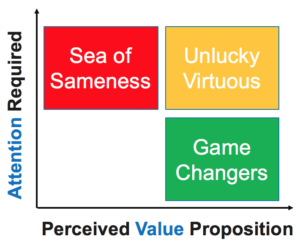
While this category is the least populated of the four, it’s still too bad when great solutions find themselves in it. The key to breakout success here is focus. More than any other category, the Unlucky Virtuous need to aggressively target their buyers. The more targeted and high-impact the outreach, the less attention will be required.
For example, organizations that provide annual flu shot vaccinations, health and wellness programs, or blood donation services often visit companies on-site to reduce buyer friction. Vendors in this category (as well as the Sea of Sameness) can also use online retargeting techniques to resurface products a buyer has already searched for (and presumably finds valuable) across digital properties to drive conversion.
Innovative Minority
Finally, we arrive where most vendors aim to be, the Innovative Minority. The “just right” Goldilocks combination of a mainstream value-proposition and a high-impact delivery mechanism, firmly rooted in science and empathy. Organizations in the Innovative Minority have figured out how to cut through the noise. They have taken products and services that may not be widely perceived as game-changing, and get buyers to disproportionately notice them by using unique and clever sales and marketing strategies.
Companies in the Innovative Minority are often created, not born. That’s good news because those stuck in the Sea of Sameness or the Unlucky Virtuous can transition to the Innovative Majority simply by incorporating some of the approaches discussed in previous posts. These include:
- using a more innovative medium like video for your outreach
- transitioning from a tiered or industry-based prospecting strategy to more focused account-based marketing (ABM) tactics
- getting prospects to pay attention using quirky tactics like old-school hand-written notes or the highly progressive piñatagram (great when used as part of an ABM strategy!)
- mobilizing the customer advocates that already love you to make referrals and warm introductions (this strategy can be so effective if done right, that the associated leads typically convert at rates 50 times higher than email campaigns)
- using bold, polarizing, and customer-centric messaging in your sales and marketing outreach to disrupt your customer’s inertia
- arming and enabling your sales team to take advantage of sales psychology principles like conviction and reciprocity in their customer interactions.
What’s even better is that those on the leading edge of the Innovative Minority can drive themselves further down the attention curve with the right approach. The key is to remember this isn’t a one size fits all proposition and organizations should never fall in love with their tactics. It’s about continuously refining and reinvesting in the winning strategies and promoting greater consistency in your approach.
In this age of relentless deadlines, limited bandwidth, and a sea solutions, many companies are encountering a new breed of customer. One with a shorter attention span and lower tolerance for their value proposition. The relationship between the perceived value of your solution and the attention you need from your target buyer to notice is one that affects every seller. Regardless of where your organization sits in this matrix, your goal should be to take an objective, data-driven approach to assessing your position, and employing the tactics that create the best results with the least amount of effort.
Which tactics are your organization using to become a coveted member of the Innovative Minority?
We promise never to send you junk or share your email! Just helpful sales insights.














Leave a Reply
Want to join the discussion?Feel free to contribute!